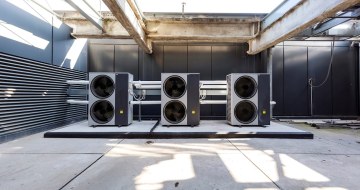
July 29, 2024 in Advisory Notes
Operational Analytics and Data Driven Maintenance (DDM)
Over the past decade, automated data analytics have been seamlessly integrated into various facets of our daily lives, including the operation and mai...
April 13, 2023

From October 2023 the updated National Construction Code (NCC) incorporates minimum requirements (within new developments) for the provision of Electric Vehicle charging infrastructure, e.g. 100% of car parks in residential and 20% of car parks in commercial buildings must be provided with EV Charging Infrastructure.
It is noted that the National Australian Built Environment Rating System (NABERS) currently allows for EVs and associated charging consumption to be excluded. This may change in the future.
EV charging, amongst other changes, such as electrification for the decarbonisation of buildings, can have a significant impact on original electrical design loads, and challenge existing electrical infrastructure. Fire protection systems including detection, suppression and fire mode ventilation systems can also be impacted.

Electrical Requirements:
Existing electrical infrastructure should be assessed with respect to suitability of switchboards and switchgear to extend the electrical infrastructure including spare capacity. (Refer to A.G. Coombs Advisory Note; Changes to Wiring and Switchboard Standards for Buildings).
An assessment should be undertaken based on the quantity of EV chargers, which considers the type of vehicle, likely charging patterns and requirements. Charging patterns can vary significantly between fleet, commercial and residential applications.
Electrical maximum demand must be assessed at the point of incoming supply to ensure overall available capacities are understood. Where EV charging is supported via existing field distribution boards electrical demands must be reviewed individually.
EV Charging Equipment:
Careful consideration should be given to selecting EV charging equipment, as some EVs are not compatible with third party EV chargers. Whist electric vehicle, and charger manufacturers are working to standardise technical requirements, it should be noted that EV chargers often have output abilities exceeding the maximum on-boarding capacity of EVs.
Electrical Infrastructure Provisions:
For most commercial and residential facilities, a Load Management System (LMS) will be required to ensure that the overall electrical load is limited to the available supply capacity. An LMS has the ability to diversify the overall connected electrical load based on the battery/charge status of each EV, e.g. EVs at low battery levels will be prioritised, while EVs at higher battery levels will receive a ‘trickle’ charge.
It is recommended to deploy a LMS with an Open Charge Point Protocol (OCPP), to enable the ready integration of different manufacturer’s equipment. The alternative is a proprietary system, which may limit options to integrate other manufacturer’s chargers.
Based on the available physical space, spare capacities and the anticipated quantity (and rating) of EV chargers, a dedicated electrical distribution system, including protection devices, sub-main cabling and dedicated distribution boards (DBs) may be required.
There are multiple options to include metering, which may also be required to enable apportioning the cost of consumption by individual EVs. However, such functions are typically integrated within an LMS, which can effectively operate like an embedded metering network.
Check metering may also be provided upstream of the EV charging infrastructure, to enable total electrical consumption to be excluded from NABERS ratings.
Where a LMS is deployed, allowances must be made for the reticulation of communications cabling from the LMS to each EV charger.
Alternatively, EV chargers can be provided with individual NMI-Metering provisions, however, the associated infrastructure requirements should include provision of an unmetered supply and furthermore will require space to facilitate the installation of NMI-Metering in accordance with relevant Rules and Regulations.
Fire Safety Requirements – Electric Vehicles and Charging within the Built Environment:
The increase in the uptake of EV’s and the installation of EV charging equipment in buildings has raised concerns about potential increases in fire severity, duration, and frequency. Electric vehicles present a new hazard due to the presence of Li-ion batteries. These can be subject to failure leading to a thermal runaway event, for which there is no effective extinguishing method. This poses significant challenges for firefighters in incident management. Battery thermal runaway events may also release toxic gases and pose additional electrical hazards compared to traditional vehicles.
While EV failure events are currently reported at a low frequency, the potential risks of a thermal runaway event can be high due to the larger consequences.
The Australasian Fire and Emergency Service Authorities Council (AFAC) has issued guidance on managing the fire risks associated with EV’s. The types of Special Hazards include but are not limited to:
• Potential for the fire event to impact on the structural integrity of the development.
• Exposure to high voltage direct current (DC) and alternating current (AC) electricity.
• Toxic and combustible vapour production.
• Potential for vapour cloud explosion.
• Potential for a rapid rate of fire spread.
• Significant fire duration (e.g. 4+ hours) and protracted incident.
• Potential for secondary ignition.
• Potential for stranded electrical energy.
• Potential for contaminated run-off from firefighting water streams.
• Post-fire management of potentially hazardous waste material.
The AFAC have formulated a list of consideration items that should be discussed with relevant stakeholders, including the fire authorities, during the planning and design phase for the implementation of EV charging equipment and the introduction of EVs within a built environment.
• Location of EV charging stations and the proximity to other vehicles, exits, other fire safety systems, building utilities and critical infrastructure.
• Establishing that the appropriate fire resistance level (FRL) is applied to building elements.
• Suitability of fire safety systems and their location in proximity to the risk, including fire hydrants, fire detection systems, occupant warning systems, automatic fire sprinkler systems, ventilation and smoke hazard management systems.
• The adequacy of vehicle separation to prevent fire spread with respect to directional flame jetting in EV fires. This includes special considerations for vehicle access in stacked parking arrangements or automatic vehicle parking systems.
• Intervention capabilities of the local fire authority.
• Potential for contaminated fire-water run-off.
• Provision of remote emergency shutdown controls and/or automatic shutdown for EV Charging Stations.
• Vehicle impact protection (e.g. bollards) for EV charging stations.
• Application of any best practice standards for EV charging equipment.
• Implementation of a regular maintenance schedule for EV charging equipment.
Fire Safety Review and Upgrade Process:
When installing EV charging facilities, the AFAC recommends the following NCC Clauses to be assessed by a Building Surveyor/Certifier:
• E1.10 Provision for special hazards
• E2.3 Provision for special hazards
This is to be carried out by assessment via the relevant NCC Performance Requirements and is typically undertaken by a registered Fire Safety Engineer. Any subsequent works and maintenance must be undertaken by qualified contractors.
The following provides a process guide for addressing Fire Safety considerations for the installation of EV charging equipment in a built environment:

Always seek professional advice when installing Charging Equipment within your facility.
It is recommended that the Deemed to Satisfy (DTS) fire protection provisions in accordance with the NCC be achieved as a minimum.
Further Resources:
A good resource to understand the complexities surrounding EVs and the risk of electric fires is provided by EV Fire Safe.
Australasian Fire and Emergency Service Authorities Council (2022) Electric Vehicles (EV) and EV charging equipment within the built environment (AFAC Publication No. 3098).
For more information about Carbon Roadmap, visit:
www.agcoombs.com.au/a-g-coombs-carbon-roadmap
|
For more information about EV charging in buildings, contact: |
|
Simon Jokic, Engineer (Electrical) – A.G. Coombs Advisory P: +61 3 9248 2700 | E: sjokic@agcoombs.com.au |
|
Marcus Royle, Leader (Fire) – A.G. Coombs Advisory P: +61 3 9248 2700 | E: mroyle@agcoombs.com.au |

July 29, 2024 in Advisory Notes
Over the past decade, automated data analytics have been seamlessly integrated into various facets of our daily lives, including the operation and mai...

June 24, 2024 in Advisory Notes
Mould plays an important role in the natural environment as a break-down mechanism for dead organic matter. In the built environment, it is an unwante...

April 30, 2024 in Advisory Notes
A lot has changed since A.G. Coombs released our first Advisory Note on heat pumps back in 2018. Increasingly, asset owners are no longer asking if he...

March 12, 2024 in Advisory Notes
Building owners and facility managers often don’t have access to a full set of accurate documentation for of their buildings to support effective an...